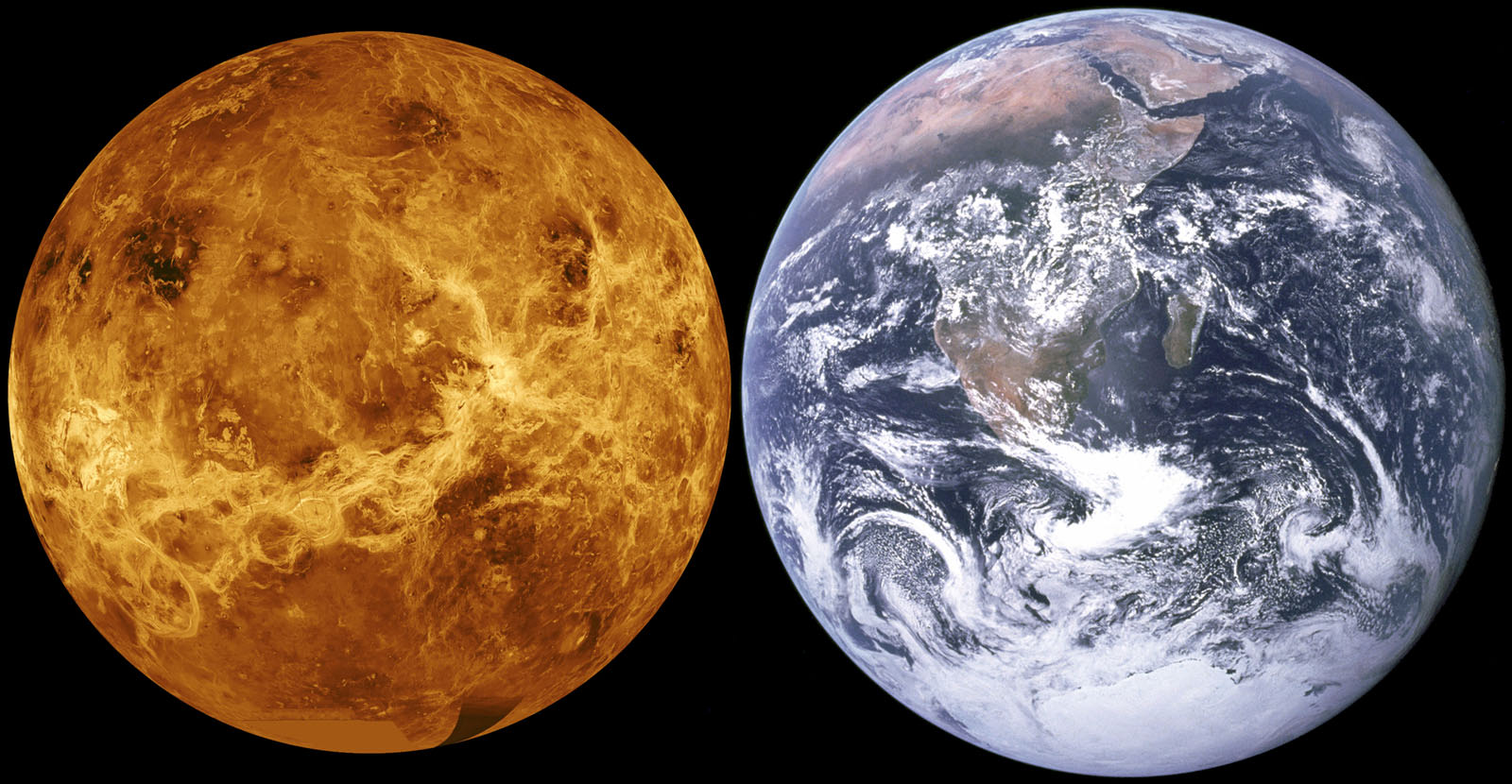Lately, there have been several missions to Mars; a number more to the Moon and the "rocky" planets in our solar system are planned. Among these, NASA and JPL are working on two missions to Venus, the planet physically very similar to Earth, but, environmentally speaking, very different.
Venus' orbit is closer to the Sun. It is also the closest planet to us, its distance from the Sun is 72% of Earth's distance. This implies that Venus may have had a climate similar to Earth's in the earlier years of its existence. It makes sense that a closer distance to the Sun would result in a higher, but still tolerable average surface temperature there. Venus orbits within the "Goldilocks" zone, nearer the inner limit. Mars orbits inside the outer limit. Water can exist in a liquid state in that zone. However, at the present time, Venus' surface temperature is about 460[!] degrees Celsius. In addition, the atmospheric pressure is about 90 times that of our home planet; the composition of its atmosphere is also very different from ours. The reason for this extreme climate change is unknown, a greenhouse gas effect, perhaps? The rotational axis of Venus is only 2.3 degrees off its orbital plane and Venus rotates "retrograde" once in 243 days; could this have contributed to the current situation? Finding a possible cause is also a purpose of the two missions.
As usual, NASA's planned Venus missions are named to have some clever, and purpose-implying acronyms. VERITAS (Venus Emissivity, Radio science, InSAR [Interferometric Synthetic Aperture Radar], Topography, Spectroscopy) will orbit Venus with the purpose of obtaining surface and interior gravitational details. Perhaps there are formations (i.e. possible traces of lake beds or river valleys) that indicate the presence of water at an earlier time. There will also be an effort to determine whether there is evidence of tectonic plates and activity in the past, or even now.
The other orbiter, DAVINCI+ (Deep Atmosphere Venus Investigation of Noble gases, Chemistry, Imaging Plus) consists of an orbiter and a lander. The lander is designed to settle on the surface of Venus, to measure atmospheric details on the way down, and surface characteristics as well. Both orbiters will probably act as communications relays. Lately, there have been some reports of detecting phosphine gas in the atmosphere, maybe indicating some form of airborne life. Others disagree. After a number of years of lax interest, Venus has come to the forefront of scientific investigation again.
To withstand the current temperatures on Venus, a lander will have to have especially well designed heat protection. Russia sent the world's first-ever lander to Venus (Venera 9) in 1975; it sent signals for a little more than 50 minutes, after which contact was lost. There have been a number of landers by both Russia and NASA since then. I think that the super-hot environment likely gets the better of most of them.
Venus' atmosphere now is mostly carbon dioxide, with sulfur dioxide clouds and sulfuric-acid rain drops. Life on Earth (you and I are included) also generates carbon dioxide all the time, much of which, via a series of chemical actions, is converted back to oxygen by plankton in the oceans, and our plants and trees. But our industrial and agricultural activities are releasing large amounts of methane (20x more efficient at trapping heat than CO2) and other pollutants, some of which also trap heat. Recent climate changes hint that global warming is happening now.
Venus and Earth are an interesting, at first glance very similar pair of planets next to each other, yet they have such amazingly different surface environments.
Are we looking at a future on Earth similar to the present conditions on Venus ? Are we smart and nimble enough to head off such future ?
If you're interested in seeing both of the other two planets sharing the Goldilocks zone, in the western sky on July 12, 2021, around 9:30 pm and later, you can see both Mars and Venus close together (and the Moon a bit farther away). Be careful if you look for Venus before sunset. It is fairly close to the Sun - the standard warning is: don't damage your eyesight, never look at the Sun with the naked eye, binoculars, or telescopes. Proper solar filters are necessary for that. After sunset, Venus, Mars, and the Moon are all close to the West North Western horizon; at that point binoculars are helpful. An unobstructed western horizon is best.
Simulated image from SkySafari 4 Plus
(References and credits: RASC Observer's Handbook, Scientific American, Wikipedia, NASA/JPL, The Planetary Report)



No comments:
Post a Comment